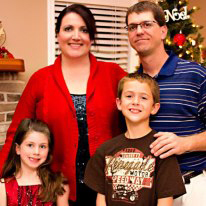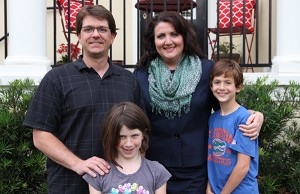The Modern Day Brady Bunch
Blended Families Cast A Second Act With Love!
In 1969, television viewers fell in love with The Brady Brunch, a comic sitcom featuring a blended family. The premise: Mike Brady, a widowed architect with three sons ─ Greg, Peter, and Bobby ─ marries Carol Ann Martin, who has three daughters ─ Marcia, Jan, and Cindy. Reportedly, the TV network objected to producers positioning Carol as a divorcée; thus, the end of her first marriage was never addressed. The large blended family, seemingly with no apparent struggles associated with reality (divorce, death, step-parents/siblings, etc.), lived happily ever after in a two-story suburban home along with Alice, the live-in housekeeper, and Tiger, the family dog. While the show downplayed (or even avoided) the transitional challenges that many blended families experience, it did illustrate that widowers and divorcées were willing to give love a second chance. According to a nationwide survey conducted by Pew Research, more than four-in-ten American adults have at least one step relative in their family – either a stepparent, step/half sibling, or stepchild. Therefore, if a Brady Bunch spin-off aired today, producers would likely not hesitate to write in a divorcée storyline.
 After ending an eight year on-and-off relationship, and with encouragement from her friends, Marilyn Moran joined Match.com, an online dating website. Her New Year’s resolution seemed simple, “I will go out on one date in 2011. Easy enough, right?” Well, as a single parent and busy lawyer, she hadn’t been on a date in years and, frankly, thought Michael Weaver was too good to be true when she received a message from him just two days into her membership. “Initially, I dismissed him as being way too nice, intelligent, employed, and emotionally-healthy for serious consideration,” admits Marilyn. She finally gave Michael (and herself) a chance with friendly dates filled with conversations centered on their young children. Five dates later, the new 40-something lovebirds shared their first kiss and nine months later, they became newlyweds embarking on their own mini tale of a modern day Brady Brunch!
After ending an eight year on-and-off relationship, and with encouragement from her friends, Marilyn Moran joined Match.com, an online dating website. Her New Year’s resolution seemed simple, “I will go out on one date in 2011. Easy enough, right?” Well, as a single parent and busy lawyer, she hadn’t been on a date in years and, frankly, thought Michael Weaver was too good to be true when she received a message from him just two days into her membership. “Initially, I dismissed him as being way too nice, intelligent, employed, and emotionally-healthy for serious consideration,” admits Marilyn. She finally gave Michael (and herself) a chance with friendly dates filled with conversations centered on their young children. Five dates later, the new 40-something lovebirds shared their first kiss and nine months later, they became newlyweds embarking on their own mini tale of a modern day Brady Brunch!
Coincidentally, their ‘premise’ has a few humorous similarities to that of America’s most beloved blended family. Michael (also goes by Mike), a divorced structural engineer, with physical custody of his one son, Matthew (whose mother lives in the U.K.), married Marilyn, who has one daughter, Madison. The small his-and-her merged group work hard to live happily ever after in a three-story suburban condo, along with Alicia, the nanny, and their two cats. Plus, their names all start with ‘M’…wait, that’s the Duggars or Kardashians, not the Bradys!
 “Until May 2012, I was a single mother of a 6-year-old girl, and then married a single father of an 11-year-old boy. We joined “tribes” and the boys moved in with the girls,” Marilyn describes. “Trying to blend our family has been a doozy. I quip that it is much more difficult than blending margaritas! There are so many issues to figure out: parenting styles, age and gender differences, stepparent role/involvement, and making time for the marriage itself while in the midst of so much change. We decided to give therapy a chance after the suggestion was made at a pre-marriage class. We’ve learned so much and implemented a number of steps, such as house rules and family meetings, to help with the blending process which, according to our family therapist, usually takes at least 7 years.” A ‘systems therapy’ specialist, Jodie Scott Rivera, Ph.D., who councils the Moran/Weaver family, says, “Blending families in an appropriate way is not a quick process. Families benefit from therapy by dealing with their own issues and learning how to adjust if needed.” There are several ingredients to blend a family:
“Until May 2012, I was a single mother of a 6-year-old girl, and then married a single father of an 11-year-old boy. We joined “tribes” and the boys moved in with the girls,” Marilyn describes. “Trying to blend our family has been a doozy. I quip that it is much more difficult than blending margaritas! There are so many issues to figure out: parenting styles, age and gender differences, stepparent role/involvement, and making time for the marriage itself while in the midst of so much change. We decided to give therapy a chance after the suggestion was made at a pre-marriage class. We’ve learned so much and implemented a number of steps, such as house rules and family meetings, to help with the blending process which, according to our family therapist, usually takes at least 7 years.” A ‘systems therapy’ specialist, Jodie Scott Rivera, Ph.D., who councils the Moran/Weaver family, says, “Blending families in an appropriate way is not a quick process. Families benefit from therapy by dealing with their own issues and learning how to adjust if needed.” There are several ingredients to blend a family:
Parenting styles:
Before remarrying, collectively agree with your mate on how to co-parent and implement adjustments prior to blending to foster a smoother transition. “Parents must decide on roles and then communicate them clearly, especially if rules are different at mommy’s house vs. daddy’s house,” explains Dr. Rivera. Since Marilyn displays an ‘authoritative’ style and Michael tends to be ‘permissive,’ they attempt to “defer discipline to the biological parent and balance a ‘friend’ role as the other parent,” however circumstances do, of course, arise. Both Marilyn and Michael admit to initially ‘playing favorites’ after moving in together which they explain as genuine “protective nature” over their individual child. Similarly, experts warn to not overcompensate by favoring stepchildren either.
Dr. Rivera acknowledges that conflicts over newly combined child-rearing styles are normal, but parents should always display a united front with children and address disagreements behind closed doors. “Unfortunately, there was one occasion when we argued in front of the kids. We apologized immediately and assured them that it was just a disagreement and not lead to a divorce.”
Limit relationship expectations but insist on respect:
 Marilyn says the kids quickly bonded as friends (prior to blending), but became competitive as stepsiblings. Step-relatives may not love each other right away, so give it time and effort. Initially overwhelmed by change, Matthew struggled to grasp that Marilyn was not trying to replace his mother. “Jodie (therapist) helped me understand why Marilyn disciplined differently than my dad and helped me trust her,” shared Matthew. “We knew the adjustment may not be immediate, but required each family member to be respectful of one another in hopes that feelings would grow,” said Michael. That strategy worked.
Marilyn says the kids quickly bonded as friends (prior to blending), but became competitive as stepsiblings. Step-relatives may not love each other right away, so give it time and effort. Initially overwhelmed by change, Matthew struggled to grasp that Marilyn was not trying to replace his mother. “Jodie (therapist) helped me understand why Marilyn disciplined differently than my dad and helped me trust her,” shared Matthew. “We knew the adjustment may not be immediate, but required each family member to be respectful of one another in hopes that feelings would grow,” said Michael. That strategy worked.
“Madison started calling Michael ‘daddy’ on her own,” says Marilyn. “I have a daddy 1.0 and daddy 2.0,” giggled Madison. It is common for younger children (under age 10) to adjust more easily, whereas tweens may take a longer transition time, and teenagers (or older) might have less involvement in the stepfamily life. Dr. Rivera councils on other differences, such as blending genders or transitioning from an only child to sibling status; although these factors did not complicate the Moran/Weaver blend. “We’ve focused on nurturing each relationship through one-on-one time. I can’t say that I’ve loved dressing up like a princess, but it’s been among many firsts for me now that I am also the parent of a girl,” Michael quips.
Outside support:
“Many families do not have a stay-at-home parent, but rather are dual-career households. Hiring help, such as a nanny or assistant, can help juggle responsibilities,” suggests Dr. Rivera. Marilyn adds, “Aside from helping with logistics, Alicia is a neutral authoritative figure so there are no ‘favorites.’ Plus, she’s brought to light issues that Michael and I weren’t aware of.” For example, Alicia, who has worked with other blended families, notes that the children get along well under her care, but notices a shift in dynamics when either parent comes home from work, which could demonstrate a competitive or attention-seeking trait.
Solid marriage:
 Dr. Rivera suggests weekly date nights to maximize the connection with one’s spouse. “If the couple’s relationship is ok, then generally the children are more likely to be ok. Remember why you fell in love!”
Dr. Rivera suggests weekly date nights to maximize the connection with one’s spouse. “If the couple’s relationship is ok, then generally the children are more likely to be ok. Remember why you fell in love!”
Marilyn and Michael say that amidst much transformation, one change has been a positive key ingredient. “We started new family traditions, including simple bonding opportunities like family TV night, church, dinnertime, cards, and other celebrations. “I like watching Survivor together,” Matthew says. As for the ‘competitiveness,’ it’s now just a display of traditional sibling rivalry. Matthew admits with a smile, “Madison is funny! Before (blending), my best pal was the cat, but now I have her.” Building a blended family can be both rewarding and challenging. With patience, understanding, and support, your modern day Brady Bunch can be a great cast of characters together!








